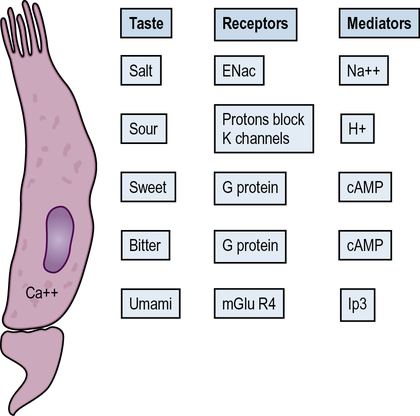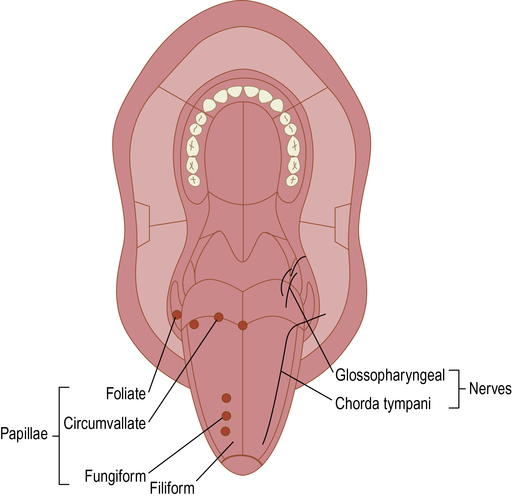Taste abnormalities
INTRODUCTION
The sense of taste is mediated by specialized taste buds – oval bodies made up of groups of neuroepithelial and supporting cells (Fig. 22.1). The neuroepithelial cells are rod-shaped with a peripheral hair-like process projecting into the taste pores at the surface of the overlying mucous membrane (Fig. 22.2). There are five basic tastes but they do not appear to be detected by structurally different taste buds:

Ca, calcium; Na, sodium; H, hydrogen; AMP, adenosine monophosphate; K, potassium; Ip3, inositol triphosphate; ENac, epithelial sodium channels; mGluR4, G protein coupled receptor
 Salt taste: mediated via sodium chloride (NaCl) ions. Na+ ions enter the receptor cells via Na+ channels, cause a depolarization, calcium ions enter through voltage-sensitive Ca2 + channels, transmitter release occurs and results in increased firing in the primary afferent nerve.
Salt taste: mediated via sodium chloride (NaCl) ions. Na+ ions enter the receptor cells via Na+ channels, cause a depolarization, calcium ions enter through voltage-sensitive Ca2 + channels, transmitter release occurs and results in increased firing in the primary afferent nerve.
 Sour taste: mediated by protons (H+), which block potassium channels causing depolarization, Ca2 + entry, transmitter release and increased firing in the primary afferent nerve.
Sour taste: mediated by protons (H+), which block potassium channels causing depolarization, Ca2 + entry, transmitter release and increased firing in the primary afferent nerve.
 Sweet taste: receptors bind glucose, which activates adenyl cyclase, thereby increasing cyclic adenosine monophosphate (cAMP), causing phosphorylation of K+ channels, inhibiting them. Depolarization occurs, Ca2 + enters and transmitter is released, increasing firing in the primary afferent nerve.
Sweet taste: receptors bind glucose, which activates adenyl cyclase, thereby increasing cyclic adenosine monophosphate (cAMP), causing phosphorylation of K+ channels, inhibiting them. Depolarization occurs, Ca2 + enters and transmitter is released, increasing firing in the primary afferent nerve.
 Bitter taste: bitter substances cause a second messenger (inositol trisphosphate (IP3)) mediated release of Ca2 + resulting in transmitter release and firing of the primary afferent nerve.
Bitter taste: bitter substances cause a second messenger (inositol trisphosphate (IP3)) mediated release of Ca2 + resulting in transmitter release and firing of the primary afferent nerve.
 Umami taste: certain amino acids (e.g. glutamate, aspartate) bind to a glutamate receptor (mGluR4) activating a G-protein, raising intracellular Ca2 +. Glutamate may also stimulate the NMDA (N-methyl-D-aspartate)-receptor, when non-selective cation channels open, and Ca2 + enters, causing transmitter release and increased firing in the primary afferent nerve.
Umami taste: certain amino acids (e.g. glutamate, aspartate) bind to a glutamate receptor (mGluR4) activating a G-protein, raising intracellular Ca2 +. Glutamate may also stimulate the NMDA (N-methyl-D-aspartate)-receptor, when non-selective cation channels open, and Ca2 + enters, causing transmitter release and increased firing in the primary afferent nerve.
The terminal branches of the nerve fibres subserving taste end in close relationship to these special neuroepithelial cells. Taste buds are found in the mucous membrane of the tongue, soft palate, fauces and pharynx, and, in the newborn, on the lips and cheeks. Taste buds on the tongue are on the fungiform, circumvallate and foliate, but not on the filiform, papillae (Fig. 22.2). Papillae at the front of the tongue have more taste buds compared to the mid-region. Taste buds are also located throughout the oral cavity, in the pharynx, the laryngeal epiglottis and at the entrance of the oesophagus. Sensitivity to all tastes is distributed across the whole tongue and to other regions where there are taste buds (epiglottis, soft palate), but some areas are more responsive to certain tastes than others:
 Fungiform papillae are innervated by the chorda tympani branch of the facial (VIIth cranial) nerve, responding mainly to sodium chloride and/or to sucrose.
Fungiform papillae are innervated by the chorda tympani branch of the facial (VIIth cranial) nerve, responding mainly to sodium chloride and/or to sucrose.
 Foliate papillae are predominantly sensitive to sour tastes. Innervated by the glossopharyngeal (IXth cranial) nerve, responding mainly to bitter.
Foliate papillae are predominantly sensitive to sour tastes. Innervated by the glossopharyngeal (IXth cranial) nerve, responding mainly to bitter.
 Circumvallate papillae confer a sour/bitter sensitivity to the posterior two-thirds of the tongue. Innervated by the glossopharyngeal (IXth cranial) nerve, they respond mainly to bitter.
Circumvallate papillae confer a sour/bitter sensitivity to the posterior two-thirds of the tongue. Innervated by the glossopharyngeal (IXth cranial) nerve, they respond mainly to bitter.
TASTE CHANGES
 Genetics are important to taste. For example, sensitivity to the bitter taste of phenylthiourea is genetically determined and some patients are genetically unable, for example, to smell fish. In contrast, people who have more than the normal number of taste papillae (and taste buds and increased density of fungiform papillae) have extreme sensitivity to n-propylthiouracil (PROP), are called supertasters and account for 25% of the population (more women than men) – they tend not to like green vegetables and fatty foods.
Genetics are important to taste. For example, sensitivity to the bitter taste of phenylthiourea is genetically determined and some patients are genetically unable, for example, to smell fish. In contrast, people who have more than the normal number of taste papillae (and taste buds and increased density of fungiform papillae) have extreme sensitivity to n-propylthiouracil (PROP), are called supertasters and account for 25% of the population (more women than men) – they tend not to like green vegetables and fatty foods.
Stay updated, free dental videos. Join our Telegram channel

VIDEdental - Online dental courses






